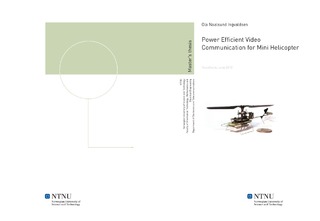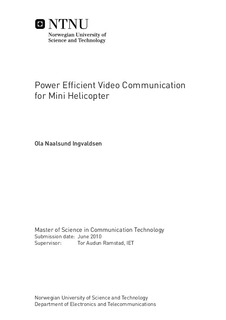| dc.description.abstract | In this thesis, a video communication system for use in a mini helicopter is reviewed. The transmitter is located in a small battery powered mini helicopter, weighing about 15 grams, and the receiver is the helicopter's remote control. The operator controls the helicopter only based on the video feed sent from the helicopter, hence it is critical that the delay is kept to a minimum. Due to the helicopter's small size, the energy available is very limited, and both coding and transmission should be efficient and have low complexity. Since processing takes considerable less energy than transmission, compressing the video is an important factor to reduce the needed transmission rate. Video compression is done using three-dimensional DPCM with motion compensation. The prediction is done around the channel noise; hence, the system uses joint source channel coding. The analog system utilizes the feedback channel already needed for closed loop DPCM to transmit every sample in an iterative fashion which expands the bandwidth to reduce transmission power. The simulations shows that for an ideal feedback channel and with a Gaussian distributed input, the system acts according to OPTA.The system is simulated in different environments and components are added to the system to make the simulations more realistic and the system more robust. The sampling period of the system with a bandwidth expansion of three is 288 ns, and with a carrier frequency of 2.39 GHz, it is reasoned that this would give flat fading in an indoor office environment.When flat fading is introduced, channel estimation and diversity are implemented to reduce the degradation caused by fading, and by adding three-dimensional DPCM, the system becomes very robust against the fast channel fluctuations caused by multipath fading. Further, in fading the iterative system experiences graceful degradation, meaning the system does not break down below a certain power but has a steady decrease in performance for decreasing Ep/No. The system shows good results (received PSNR greater than 40 dB) for an average Ep/No of 3.5 dB in the receiver, averaged over all test inputs.Simulations shows a substantial gain in lowering of the variance of the transmitted signal by video compression. For high Ep/No, the transmission power can be reduced by 17 dB to yield the same result as with no compression. | nb_NO |

